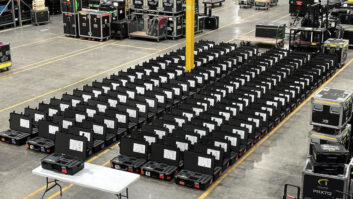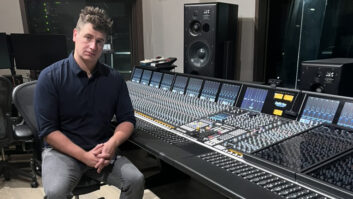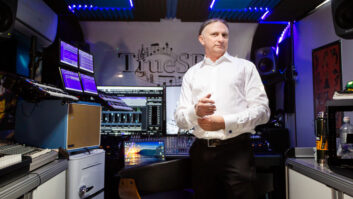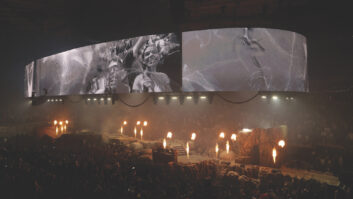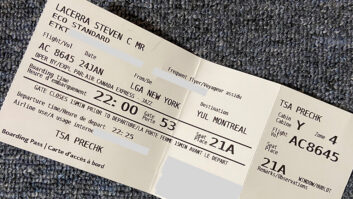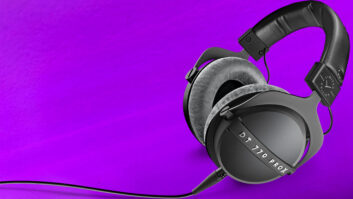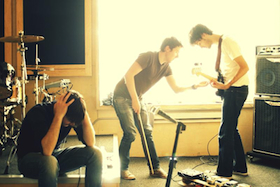
Autumn Owls
Ireland’s atmospheric indie-rock trio Autumn Owls are set to release their first full-length album, Between Buildings, Toward the Sea October 23 on Epitonic. Gary McFarlane (vocals/guitar), Adam Browne (bass) and Will Purtill (drums) enlisted producer Brian Deck and mixing engineer Ciaran Bradshaw to help create the rich textures and sometimes soothing, sometimes haunting sounds of their debut LP.
Deck, working at Engine Studio in Chicago, recorded the band to Pro Tools 24-bit, 88.2kHz. “I’m done with tape,” Deck says. “I haven’t heard any tape that sounds as good as 456 used to. And really, anyone who romanticizes the ‘sound’ of tape didn’t spend the first 12 years of their career trying to get it to give back what you put in.”
The album opens with “Semaphores,” delivering spacey, haunting vocals. “In the intro of the song, we treated the vocal with the same processing that the band used on their demo,” Deck says. “The distortion comes from the SansAmp plug-in and the ambience comes from the DigiRack Non-Lin Reverb. I used two reverse reverbs: One short mono plate and one longer stereo hall, both made with AltiVerb by reversing the vocal track, printing the reverb and then reversing the reverb and lining it up with the original vocal track. The process is really exactly the same as what we used to do with reels of tape.”
Bradshaw adds, “For the start of the track, we distorted the vocal track quite heavily and then filtered it through an MS-20 synth before recording it back in to Pro Tools. This track stays in for the whole song at various levels. When the drums kick in, a cleaner vocal comes in over the top.”
With regard to the song’s eerie tone, McFarlane adds, “We got the sound for the intro by jamming a small mic inside my 12-string guitar,” McFarlane adds. “One of us held the chord and the other struck the body of the guitar with a mallet. The guitar has a big jumbo body so the hum really resonates. We then slowed down the sound and lowered the pitch. The result is a really eerie organ-like sound that runs right through the song.”
Click “Next” to read an extended Q&A with Brian Deck, Ciaran Bradshaw, and Gary McFarlane.
BONUS Q&A WITH BRIAN DECK, CIARAN BRADSHAW AND GARY MCFARLANE
Can you explain the step-by-step process of creating “Great Atlantic Drift,” from writing to recording to mixing?
McFarlane: I wrote “Great Atlantic Drift” on a crappy classical guitar in Tangier, Morocco. We first performed the song at an acoustic show in Galway about two months later. We added the barre chord bass line for that version, which went on to become an integral part of the final arrangement. It was one of the first songs we demoed for the album and became a project in deconstruction. The more we worked on the song the more of the original rhythm guitar came out. This gave us the space to experiment with sonic details and add ambient layers such as bowed glockenspiels and electronic drum samples.

Brian Deck
Deck: The band had gone through a very long and thorough demoing of these songs before we ever were introduced. They had worked and reworked these songs a lot! We kept the lion’s share of the programming they had done. We didn’t fiddle too much with the arrangements, either. In most if not all instances we began work in Chicago from the Pro Tools’ sessions they had brought with them.
We spent about as much time on preproduction as we could, considering the distance involved. We had a series of Skype discussions about the music where I would tell the guys various things I had noticed about the music—things I particularly liked that I thought we could focus on more or places where I thought a little more melodic development could happen.

Ciaran Bradshaw
Bradshaw: From a mixing perspective, the first half of this song is mainly drums, bass and vocals with various other instruments and noises coming in and out. I really wanted to create a sense of vastness with the rhythm section that I could float the vocal in the middle of and then have all the other bits jumping in and out from different places.
Brian had a spot mic on the side of the floor tom to catch Will’s stick hitting the shell. I compressed, distorted and filtered the hell out of that mic to bring up all the ring and the overtones of the floor tom and to dirty up the sound of the kit a little. That mic along with overheads and the room mic are the sound of the kit. Well, that and the Valhalla Room reverb just to add a little extra air. That’s a great plug-in by the way—it’s an insanely good value. There’s probably a touch of the other close mics to add a bit of weight, but mainly it’s just those three.
Bass was nicely compressed on the way in, I didn’t feel it needed anymore so I just EQed to get it sitting where I wanted. I automated that EQ for the different sections of the song as needed.
There’s a middle section with a lot of pianos playing. There’s two doing the big hits, a nice posh-sounding one the guys recorded in Chicago and, let’s say, a not-so-posh-sounding upright the band recorded themselves. These were panned out about 9 and 3. Then there’s an ambient piano doing the melody line.
From there on the track gets a little fuller. I wanted to gradually bring everything a little closer and more intense so there’s a lot of automation from that point. It’s all quite slow though, reverbs gradually pulling back, EQs shifting around, etc….
The vocal chain was a [Massey] De:Esser, Sony Oxford EQ for corrective EQ, out to a [Empirical Labs] Mike-E Compressor and probably through a Midas EQ for some air and low-end boost, back into Pro Tools, and I think in this case another de-esser.
And for the vocal effects, I used a spring reverb that I pulled out of an old fender amp, a scuzzy “stereo” verb made up of a two different guitar pedal reverbs, a short ambience and a Massey TD5 delay. The overall level of those and the blend between them changes throughout the track.
There’s quite a lot of volume automation throughout the track. I didn’t want too much compression going on that might stifle the dynamics of the performances, so I had to do lots of little fader rides.

Massey De:Esser
How did you lay down the tracks?
McFarlane: Drums and bass were put down together in the live room in Engine Studio. The lads were well rehearsed and put down the tracks in no time. I did my guitar parts separately, due to my fussy nature for tones and because very few of the songs have the same guitar sound from start to finish. The guitar parts were recorded in Soma a few days after the drums and bass tracks. After that it was a matter of making sure the more ambient noises that were recorded at home in Dublin still lined up and worked with the new recordings.
What are the key pieces of gear or software in making Between Buildings, Toward the Sea?
McFarlane: We do like to play with recording speed for creating unusual guitar tones and drum samples. Avid’s X-Form plug-in was very useful for this. Another Avid plug-in called Synchronic was great for slicing up sounds into interesting offset loops. As for gear, I suppose my trusty Taylor 210e acoustic guitar deserves a mention as nearly every song was written on that. We had a lot of fun with effects pedals, especially the HOG from Electro-Harmonix, which we used on both guitar and keys.

Ciaran Bradshaw’s pedals
Deck: Two of the greatest consoles ever built were employed in the making of this record. We cut basics at Engine Studios on their newly restored Sphere Eclipse C. It’s a wonderful-sounding console. A lot has been said about it having certain characteristics of Neve and certain characteristics of API. It just sounds great! Everything has proper weight and detail and clarity and harmonic prettiness. Theirs had two fantastic EQs—the graphic inductor one and the parametric IC one. Both super useful and great sounding. Every other console I’ve used has problems. Smooth but bulbous. Aggressive but tinny. Whatever. I wish they made these things new.
The other one was the Trident A Range at Soma Studios in Chicago. All the guitar overdubs and vocals were cut with it. This console should need no introduction to Mix readers. It’s a mother**ker.
I’d also have to say the Urei 1176 and LA-3 and the Neumann U367. This is a mic you don’t see in many collections. Engine has four of them. They are great on most things. They were the drum overheads and rooms. I used one on a couple acoustic guitar tracks and on piano. It probably would have won the vocal mic shoot-out if we had done vocals at Engine.

Sony Oxford
Bradshaw: For me, it’s the Korg MS-20 Filter section.
Do you have a studio fix-it tip?
Deck: It’s not a technical fix. It’s a guideline, an approach. We spent a lot of time talking about this in preproduction. I think that all things are of greater potency in the presence of their opposite. The demos were very dreamy and atmospheric. I pushed to get more moments that were present to help throw the atmospheric bits into greater relief. It’s a general principle that I use all the time.
Bradshaw: Embrace what you perceive as a mistake! I think uniqueness is invaluable in a record. There’s no “correct” sound so just take the hiccup—do something to make it sound awesome and turn it up!

